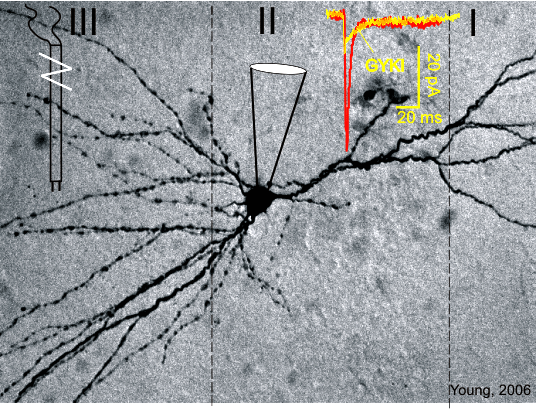FacultyQian
Neuroscience Department
 |
Publications
|
Research
One of the amazing characters of our brain is its ability to learn and to adapt. This capacity of learning is enormous when we are young. In addition, injury to the immature brain results in much more elaborate reorganization than that observed with comparable injuries in adulthood. Many studies have shown that the immature brain is able to change its structural or functional architecture after only a very short period of excitation, and these changes can last through lifetime. A major goal of my lab is to understand how learning takes place inside the normal developing brain and maladaptive reorganizations take place in the injured brain, with a goal to use this information for therapeutic purposes.
 |
|
Click here to visit the Sun lab website.
How do we achieve this goal? Methodology wise, we will combine the use of cutting edge electrophysiological recording and imaging techniques, the use of transgenic rodents that express green fluorescent proteins (GFP) in nerve cells, the use of computer aided morphological reconstruction techniques and computer-based modeling of single cell and circuit. We will investigate the communication between nerve cells in several specialized brain region, including barrel cortex. The ‘barrels' represent somatotopically sensory whiskers and can be visualized at high resolution in living brain slices maintained in artificial cerebral spinal fluid. The formation of barrels are high plastic, depend largely on the activities (experiences) of the whiskers of the rodents. By studying the structural and functional changes of barrel structure near the ‘critical periods', we can gain enormous insights into the way in which our brain develops, learns and recovers from diseases and trauma. We are currently headed toward these directions:
 |
1. Understanding of the Cerebral Microcircuits and Neural networks
We are interested in understanding the basic electric and genetic ‘building blocks' for the cerebral cortex. One potential future direction of the lab is to focus on the plasticity of microcircuits at different physiological states, such as before and after training, and pathological conditions such as drug abuse, or hyperexcitability. This type of study will help us to gain further insights into the mechanisms underlying several neurological disorders such as schizophrenia, epilepsy, cortical dysphasia, depression and increase learning potentials for normal adults.
2. Interaction of Novel Membrane receptors and ion channels
We are interested in the physiological and pathological roles of several membrane receptors, particularly novel G-protein coupled receptors and their downstream second messengers, in regulating ion channels and synaptic transmission in the forebrain. We are very interested in collaborating with labs whose focuses are cloning and expression of novel membrane receptors in the forebrain. We are also interested in mechanisms underlying modulatory effects of G-protein coupled receptors on neural networks. Another interest of the lab is to study function of endogenous activation of G-protein coupled receptors by endogenous neuronal waves generated during sleep wakeful cycle and epilepsy.
3. Cerebral Cortical Development and Malformation
We are also interested in elucidating mechanisms underlying the experience-dependent plasticity, maturation and malformation of the forebrain. We are very interested in collaborating with labs whose emphasis is studying genetic and proteomic mechanisms of brain development. We would like to take advantage of progresses generated by these labs and extend toward deeper understanding the functional and physiological consequences of the novel genes and proteins in the cerebral cortex.
